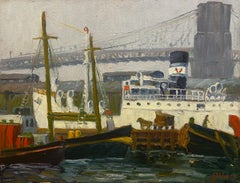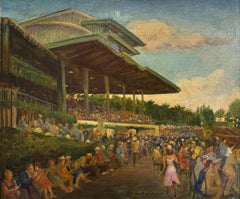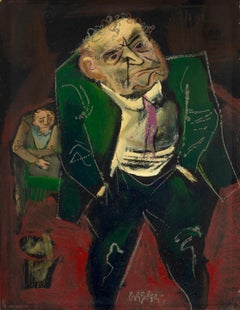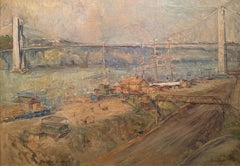Want more images or videos?
Request additional images or videos from the seller
1 of 7
Wayman Adams"Fox Trot" Wayman Adams, circa 1915 New Orleans Figures Dancing American Scenecirca 1915
circa 1915
$31,500List Price
About the Item
- Creator:Wayman Adams (1883 - 1959, American)
- Creation Year:circa 1915
- Dimensions:Height: 22 in (55.88 cm)Width: 18.5 in (46.99 cm)
- More Editions & Sizes:Unique WorkPrice: $45,000
- Medium:
- Movement & Style:
- Period:
- Condition:
- Gallery Location:New York, NY
- Reference Number:1stDibs: LU1841215067842
About the Seller
5.0
Platinum Seller
Premium sellers with a 4.7+ rating and 24-hour response times
Established in 2022
1stDibs seller since 2022
122 sales on 1stDibs
Authenticity Guarantee
In the unlikely event there’s an issue with an item’s authenticity, contact us within 1 year for a full refund. DetailsMoney-Back Guarantee
If your item is not as described, is damaged in transit, or does not arrive, contact us within 7 days for a full refund. Details24-Hour Cancellation
You have a 24-hour grace period in which to reconsider your purchase, with no questions asked.Vetted Professional Sellers
Our world-class sellers must adhere to strict standards for service and quality, maintaining the integrity of our listings.Price-Match Guarantee
If you find that a seller listed the same item for a lower price elsewhere, we’ll match it.Trusted Global Delivery
Our best-in-class carrier network provides specialized shipping options worldwide, including custom delivery.You May Also Like
Women's City Club, Youngstown, Ohio. American Historical Scene Painting.
Located in Marco Island, FL
An accomplished American Scene painter, Clyde Singer successfully captured everyday life during his long career. A unique aspect of American life is depicted in this painting, entitl...
Category
1940s American Realist Landscape Paintings
Materials
Oil, Board
$32,000
H 19 in W 27 in D 3 in
Interior J&L Works, Pittsburgh, Pennsylvania American Industrial Scene Painting
Located in Marco Island, FL
An interior scene of industrial America where workers kept the production of steel going in Pittsburgh, Pennsylvania. This detailed and atmospheric painting shows the hard work and ...
Category
20th Century American Realist Interior Paintings
Materials
Oil, Board
$4,800
H 22 in W 26 in D 1 in
Twosome - Meeting for Coffee Original Oil Painting. 20th Century Coffee Date.
Located in Marco Island, FL
American life is captured in this Clyde Singer painting, Twosome (1991), where he depicts a couple meeting for coffee. An accomplished American Scene painter, Singer successfully cap...
Category
Late 20th Century American Realist Figurative Paintings
Materials
Oil, Board
Market Woman- American Regionalist Oil Painting of Mid-Century City Life
Located in Marco Island, FL
Mid-century city life is captured in this Clyde Singer painting, Market Woman, where he depicts a woman with her shopping in 1955. An accomplished American Scene painter, Singer su...
Category
1950s American Realist Figurative Paintings
Materials
Oil, Board
$8,000
H 23.5 in W 15 in D 2 in
Red Coat - Mid-Century Figurative American Painting. Woman in New York City.
Located in Marco Island, FL
American life is captured in this Clyde Singer painting, Red Coat, where he depicts a woman walking down the street towards her destination in 1956. An accomplished American Scene pa...
Category
1950s American Realist Figurative Paintings
Materials
Board, Oil
The Red Ribbon. American Regionalist Scene Painting. Ohio Artist and History.
Located in Marco Island, FL
Everyday American life is captured in this Clyde Singer painting, The Red Ribbon (1939), in which he depicts a moment in the city. An exceptional close-up portrait of a woman walkin...
Category
1930s American Realist Figurative Paintings
Materials
Oil, Board
$15,000
H 19 in W 19 in D 2 in
City Peril. Mid-Century American Urban Scene Oil Painting of Crime.
Located in Marco Island, FL
The danger of American life is captured in this Clyde Singer painting, City Peril (1958), where he depicts a moment in the city where a woman is targeted while walking. An accomplish...
Category
1950s American Realist Figurative Paintings
Materials
Oil, Board
$14,000
H 15.5 in W 13.5 in
Standing Figure - Mid-Century American Portrait Painting
Located in Marco Island, FL
Mid-century city life is captured in this Clyde Singer portrait, Standing Figure, where he depicts a woman posing in 1954. An accomplished American Scene painter, Singer successful...
Category
1950s American Realist Figurative Paintings
Materials
Oil, Board
Snow in the City, American Winter Scene Painting, Ornate Frame, Mid-Century Oil
Located in Marco Island, FL
American life is captured in this Clyde Singer painting, Snow in the City (1954), where he depicts an everyday moment in the city. An ordinary scene, of a group of women making thei...
Category
1950s American Realist Figurative Paintings
Materials
Oil, Board
$50,000
H 41 in W 36 in D 4 in
After The Shower-Mid-Century Street Scene Oil Painting. Realist Urban America.
Located in Marco Island, FL
American life is captured in this Clyde Singer painting, After the Shower (1949), where he depicts a woman walking down the street after a storm with her umbrella in hand. An accompl...
Category
1940s American Realist Landscape Paintings
Materials
Oil, Board
$19,500
H 25 in W 41 in D 2 in
More From This Seller
View All"The Ordell, Brooklyn Bridge" Margaretha E. Albers, New York Urban Cityscape
By Margaretha E. Albers
Located in New York, NY
Margaretha E. Albers
The Ordell, Brooklyn Bridge
Signed LR
Oil on artist board
12 x 16 inches
Provenance
Kennedy Galleries, New York
Private Collection, New York
St. Lifer Art, New...
Category
1930s American Realist Figurative Paintings
Materials
Oil, Board
"Hialeah Park Race Track, Florida" Beatrix Sherman, American, Mid 20th Century
Located in New York, NY
Beatrix Sherman
Hialeah Park Race Track, Florida, 1947
Signed lower right
Oil on canvasboard
16 x 20 inches
Beatrix Sherman (1894-1975), who changed her first name from Beatrice by...
Category
1940s American Realist Figurative Paintings
Materials
Canvas, Oil, Board
"Senator" William Gropper, Social Realism, WPA Political Art, Caricature
By William Gropper
Located in New York, NY
William Gropper
Senator
Signed lower center
Oil on board
16 x 12 1/4 inches
ACA Galleries, New York
Private Collection, New York
Bonhams, American Art Online, August 23, 2023, Lot 3...
Category
Mid-20th Century American Realist Figurative Paintings
Materials
Oil, Board
"Building the Westside Highway" Frida Gugler, 1930s New York City Urban Scene
Located in New York, NY
Frida Gugler
Building the Westside Highway (Near the George Washington Bridge), circa 1935-37
Signed lower right
Oil on canvas
20 x 28 inches
Born in Milwaukee, Wisconsin, the pain...
Category
1930s American Realist Figurative Paintings
Materials
Canvas, Oil
"Playground, Carl Schurz Park" George Picken, New York City, East River, UES WPA
By George Picken
Located in New York, NY
George Picken
Playground, Carl Schurz Park, 1938
Signed and dated lower left
Oil on canvas
28 x 36 inches
Provenance:
Estate of the artist
A native New Yorker, George Picken was born in 1898. His father, an artist and photographer, emigrated from Scotland; his mother came from Wales. They joined other European immigrants settling in New York City’s Hell’s Kitchen. Picken enlisted in the army during World War I and saw action at Verdun. After the war, he stayed in France and like many Americans returning from the vibrant Paris art scene, was inspired by the radical movement known as Impressionism. Upon his return Picken decided to follow in his father’s footsteps and become an artist.
George began his studies in 1919 at the Art Students League during Robert Henri, Max Weber, and John Sloan’s tenure. There he took classes in studio art, illustration, and etching through 1923 studying extensively with George Bridgman. The writings of French philosopher Henri Bergson were widely circulated among the artistic community and looking at Picken’s early paintings one cannot help but wonder if as a young artist he was influenced by Bergson’s ideas. Bergson said, "[There are] two profoundly different ways of knowing a thing. The first implies that we move round the object; the second that we enter into it. The first depends on the point of view at which we are placed and on the symbols by which we express ourselves. The second neither depends on a point of view nor relies on any symbol. The first kind of knowledge may be said to stop at the relative; the second, in those cases where it is possible, to attain the absolute.”
Picken’s recognition came early with showings of his work while he was a student. His drawings were published in the New Masses, a significant left-wing publication. The New York Public Library honored him with one-man shows in 1924 and 1928 and his work was included in group exhibitions at the Louis Comfort Tiffany Foundation, the Whitney Studio Club, Montross Gallery, and the Art Students League. During this time Picken married Viola Carton, one of Reginald Marsh’s models, and they lived in Westchester. Later they moved to Yorkville in Manhattan between 82nd street and East End Avenue where they began their family. Picken’s grandson Niles Jaeger recalled that, “Grandpa’s home and studio were in a five-story walk-up apartment, heated only by a coal stove. But there were wonderful views of the East River and the Queensborough Bridge...
Category
1930s American Realist Landscape Paintings
Materials
Canvas, Oil
$22,400 Sale Price
20% Off
"Woman Listening" Honore Sharrer, Magical Realism Landscape with Flora & Figure
By Honore Sharrer
Located in New York, NY
Honore Sharrer (1920 - 2009)
Woman Listening
Signed lower right
Caseine on paper
15 x 20 inches
Provenance:
Forum Gallery, New York
Private Collection
...
Category
Late 20th Century American Realist Landscape Paintings
Materials
Paper, Casein
$8,800 Sale Price
20% Off
Recently Viewed
View AllMore Ways To Browse
Oil Paintings Of Ballerinas
Roger Fry
Scottie Wilson
Vintage Girl Reading
Vladimir Dimitrov
Airplane Paintings
Anna Mary Robertson
Architectural Relief Sculpture
Breast Painting
Devil Oil Painting
Diving Board
Ferrari Car Art
French Soldier Painting
Golf Painting Framed
Gun Oil Paintings
Irving Oil
Jean Puy
Mandala Thangka



